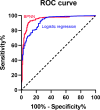Risk factors and diagnostic prediction models for papillary thyroid carcinoma
- PMID: 36133306
- PMCID: PMC9483149
- DOI: 10.3389/fendo.2022.938008
Risk factors and diagnostic prediction models for papillary thyroid carcinoma
Abstract
Thyroid nodules (TNs) represent a common scenario. More accurate pre-operative diagnosis of malignancy has become an overriding concern. This study incorporated demographic, serological, ultrasound, and biopsy data and aimed to compare a new diagnostic prediction model based on Back Propagation Neural Network (BPNN) with multivariate logistic regression model, to guide the decision of surgery. Records of 2,090 patients with TNs who underwent thyroid surgery were retrospectively reviewed. Multivariate logistic regression analysis indicated that Bethesda category (OR=1.90, P<0.001), TIRADS (OR=2.55, P<0.001), age (OR=0.97, P=0.002), nodule size (OR=0.53, P<0.001), and serum levels of Tg (OR=0.994, P=0.004) and HDL-C (OR=0.23, P=0.001) were statistically significant independent differentiators for patients with PTC and benign nodules. Both BPNN and regression models showed good accuracy in differentiating PTC from benign nodules (area under the curve [AUC], 0.948 and 0.924, respectively). Notably, the BPNN model showed a higher specificity (88.3% vs. 73.9%) and negative predictive value (83.7% vs. 45.8%) than the regression model, while the sensitivity (93.1% vs. 93.9%) was similar between two models. Stratified analysis based on Bethesda indeterminate cytology categories showed similar findings. Therefore, BPNN and regression models based on a combination of demographic, serological, ultrasound, and biopsy data, all of which were readily available in routine clinical practice, might help guide the decision of surgery for TNs.
Keywords: Bethesda category; back propagation neural network; diagnostic prediction; logistic regression analysis; papillary thyroid carcinoma.
Copyright © 2022 Zhang, Ze, Sang, Shi, Bi, Shen, Zhang and Zhu.
Conflict of interest statement
The authors declare that the research was conducted in the absence of any commercial or financial relationships that could be construed as a potential conflict of interest.
Figures
References
Publication types
MeSH terms
LinkOut - more resources
Full Text Sources
Other Literature Sources
Medical
Miscellaneous



